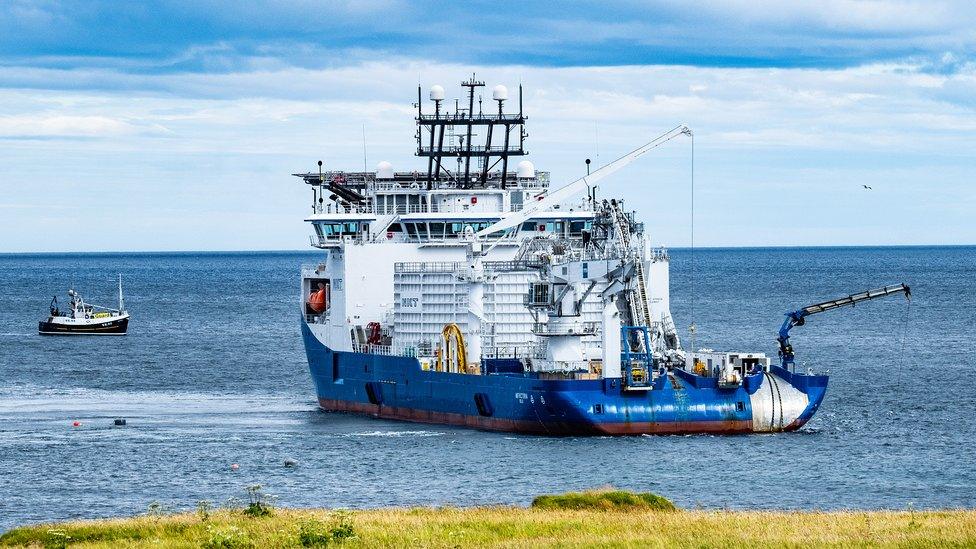The looming battle over pylons for green energy
- Published
- comments
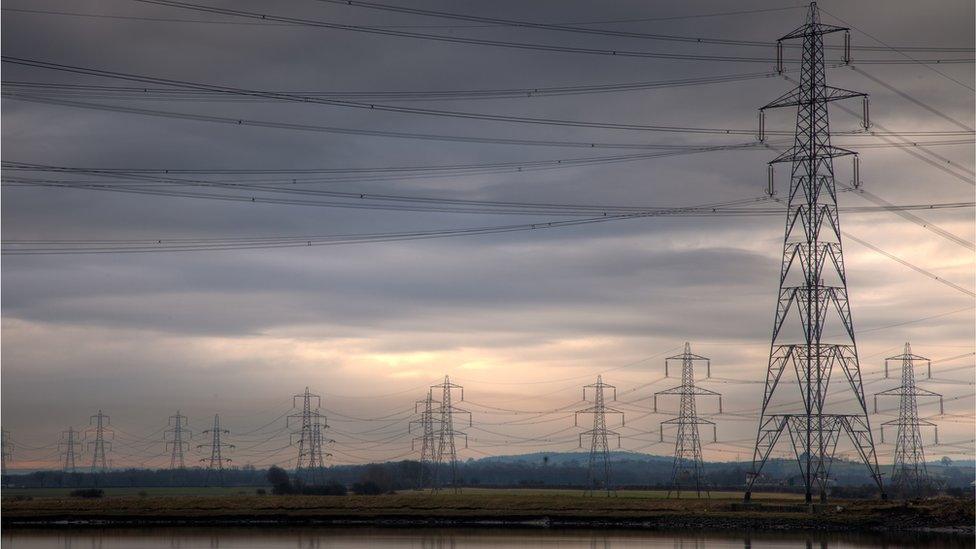
The Great Energy Transition from fossil fuels to renewable energy has numerous dimensions: jobs lost and others created, electric vehicles, biofuelled planes, scrapped gas boilers and triple glazing.
But to those who live in rural communities near the picturesque village of Beauly, it means pylons and cables in four directions, a vast new substation, and the "Beauly buzz" that keeps some awake at night.
They are at the crossroads of a vast network of infrastructure being planned to bring power from where it will be generated within a decade, and to funnel it through the central Highlands towards the homes, businesses, hospitals and schools to the south where most of the demand is.
With a budget of £10bn, SSE Networks Transmission (SSEN) has a large share of more than £50bn that rewiring Britain is expected to cost. It is spending around two-thirds of its budget on sub-sea links, but it is the onshore links that are whipping up squalls of opposition.
Battles to protect scenic and environmentally sensitive areas from the march of ever-bigger wind turbines are now moving to pylons and cables.
And where these skirmishes used to be isolated to one or at most two communities affected by a wind farm, the campaigns are now strung along routes, like beacons.
From the north, one high-voltage line is planned to bring power 107 miles from a sub-station at Spittal near Wick in Caithness, across sensitive peatlands, past Sutherland's eastern villages of Golspie and Brora, over the Kyle of Sutherland near Bonar Bridge and through Easter Ross to Beauly.
That's in addition to a sub-sea cable that takes high-voltage current from Caithness to the coast of Moray.
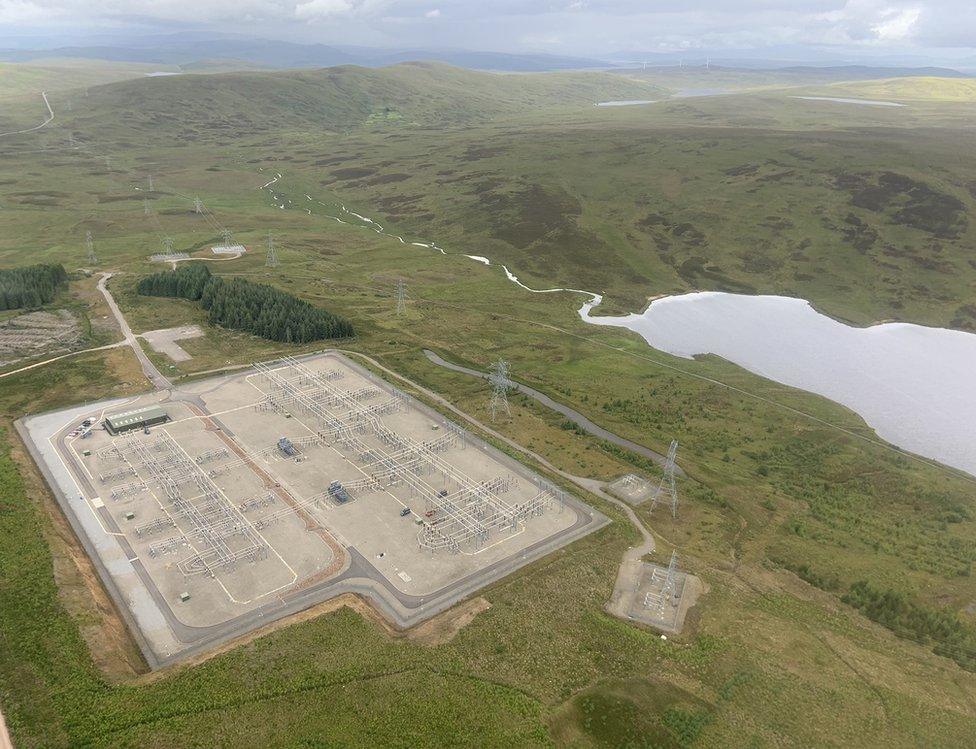
Substations, like this one at Loch Buidhe will need to be expanded to cope with the extra capacity
From the west, a further cable has been approved to bring power from the Isle of Lewis and the offshore floating wind farms being planned for the Hebridean island's north and west coast.
That cable under the Minch makes landfall at Dundonnell, south of Ullapool, and will run underground from west to east coasts, where a large plant will transfer its direct current (DC) to the alternating current (AC) on which the rest of the grid works.
DC at high voltage is seen as a more effective way to transmit power over distance and under water, and takes up a narrower corridor of land when it is buried - but it costs a lot to transform it to and from AC.
Power is coming from the North Sea, through a further gigantic sub-station at Peterhead across Aberdeenshire, Moray and Nairn, with further substation infrastructure planned for New Dear and Blackhillock.
A further grid upgrade means pylons, cables and substations stretching south from Kintore through a substation planned for Fiddes and through Angus.
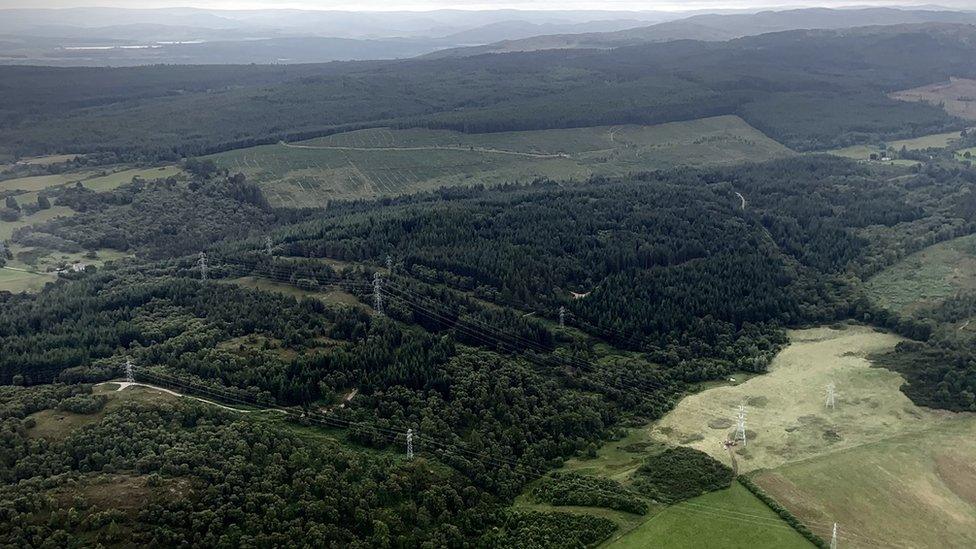
Previous upgrades to the existing power line seen here near Beauly were controversial
Going south from Beauly, a high-voltage line has been part of the national electricity grid since 2015.
The Beauly-Denny line became famous and infamous as the battle over pylons of up to 60 metres (197ft) through the central Highlands, at their most obvious to road and rail travellers at the Drumochter Pass north of Pitlochry, and connecting to the southern network at Denny near Falkirk.
That took 14 years in planning and disputes, including five years for a public inquiry. Approval was given with numerous mitigating requirements to compromise with communities who did not want to see pylons and nature campaigners who worried about habitat.
That route is 130 miles long. The scale of what is now being planned is roughly three times as big. And following public meetings along the routes through spring and summer, campaigners believe they can tie this in knots if they secure public inquiries.
Some want the planned routes re-directed, away from homes, or at least away from their homes, or the cables undergrounded or laid under the sea.
Others are not interested in mitigations, but want the industrialisation of the Highlands to stop, saying the developer has not proven a need for so much intrusion into the landscape.
In an uncompromising campaign from the Kiltarlity and Kilmorie communities near Beauly, its leaders say they are getting regular contacts from others along these routes, now including those in the Mearns area south of Aberdeen.
Lyndsey Ward points beyond the red deer stags grazing in her garden to the route the pylons and cables are likely to take, within 170 metres (557ft) of her remote hilltop home.
But she is not a NIMBY she insists - it is not a matter of "Not In My Back Yard" so much as "not in anyone's back yard", she says.

Lyndsey Ward believes there are alternative ways of delivering low carbon energy without damaging the landscape
SSE hasn't proven the need for this infrastructure, she says. If people in the south want low-carbon energy, Communities B4 Pylon Companies says they should have their own wind turbines and power pylons near their homes, and they can develop nuclear power, or solar, or import solar energy from the Mediterranean.
"We don't think we need it," she says. "We've asked SSEN to give us evidence of need and they've failed to do that. If they can prove need, we'll listen to them and we'll talk solutions. But until they do that, there's no point in talking about it."
She is not disputing the need to shift from fossil fuels, insisting she is not against renewable power. Her campaign is for it to become more localised.
This overlooks any evidence that the quality and consistency of the wind resource in and around the north of Scotland is far better than wind power further south.
"We've got enough for Scotland's need. That's when the wind's blowing. When the wind's not blowing, we still need something else," says Ms Ward.
"England can't take it. Their grid structure isn't up to doing it, and won't be for a decade."
There have been campaigns in the south of Scotland too, and a growing realisation that the extent of offshore wind in the North Sea will require much more cabling to get power from England's east coast, across its fens and flat fields and into the bigger cities.
Some of that power will come from "boot-strap" cables linking the north-east of Scotland with English landfall sites.
One such high-voltage direct current (HVDC) cable already links Hunterston in Ayrshire with north Wales, and is occasionally used to bring power north when the wind drops and Scotland needs to import energy.

The Torness nuclear power plant in East Lothian is currently due to close in 2028
When Torness nuclear power station has to close, and with no prospect of nuclear power being allowed a new generation in Scotland, there will be more such imported energy necessary.
In the south of Scotland, a division of Scottish Power has a monopoly on the transmission system, inherited from its days as a nationalised company. In England and Wales, that role is played by National Grid.
In the north of Scotland, transmission is the responsibility of a division of SSE, which was also a nationalised company as "the Hydro Board". It re-shaped the map of the Highlands with vast hydro schemes, which brought power and people into the Highland glens, much of that in the 1950s.
SSE Networks Transmission has the task of designing that network, persuading regulators its plans are at reasonable cost and profit, and persuading the public to accept new grid connections across its extensive and environmentally-sensitive region.
Its regulator, Ofgem, wants to see evidence that the lowest cost options have been thoroughly explored. It speaks for the end customer, who will have the cost of this £10bn project added to bills.
But the lower the cost, the more the scheme relies on pylons, which is antagonising at least some of those who live nearby.
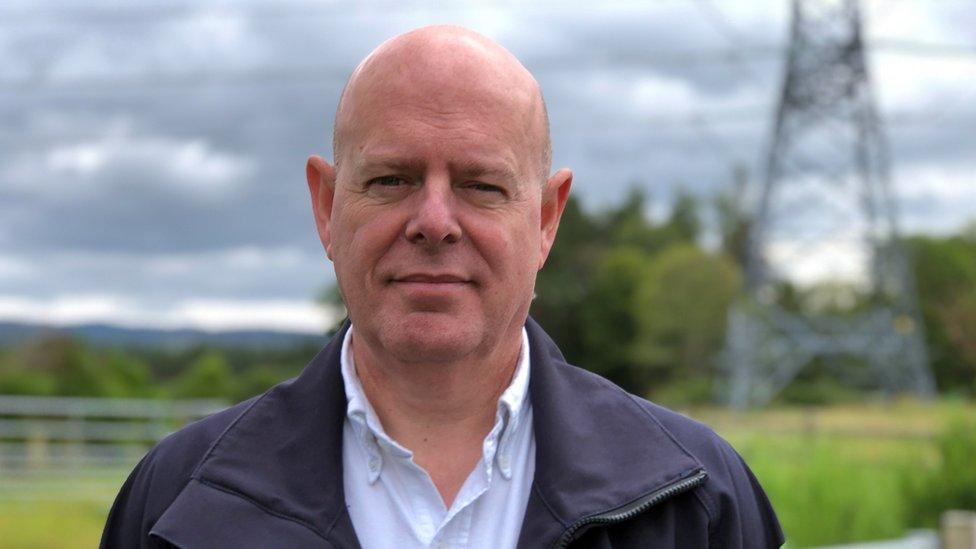
SSEN's Rob McDonald says politicians will have to explain to the public why these projects are needed
SSEN Transmission is not looking for sympathy, but its managing director Rob McDonald is looking for both UK and Scottish governments and energy regulators to step up and make the case more strongly for what the company is being required to do.
As local MPs and MSPs voice the concerns of constituents, Rob McDonald, managing director of the division, diplomatically reminds them that his job is to put into practice the consensus across governments and parties:
"These projects are really important in terms of delivering the UK and the Scottish governments' climate change and energy security targets.
"This is a portfolio of projects which has been approved by the energy system operator and the energy regulator Ofgem, which is about delivering the UK's energy ambitions."
In other words, this is SSEN doing the work for others, and on a tight leash in terms of the programme's profitability.
"Both the UK government and Scottish government are very supportive of these projects. They're supported by opposition parties in terms of the climate ambitions they're trying to address here. So there's broad support for what we're trying to achieve here.
"We're in the early stages of consultation, and as we go through this process of consulting with the public, we're going to have to hear from the politicians and the regulators about why these projects are needed."
ScotWind expansion
It is expected to deliver the infrastructure that will be necessary if targets and ambitions are to be met for ScotWind, a colossal build-out of wind power capacity in the waters around Scotland.
That is a world-class resource of relatively strong and consistent wind, with the deployment of both fixed and floating turbines rising more than 200 metres (656ft) above the sea.
The industry bid for the right to develop more than 27 gigawatts of capacity in this round of offshore wind - more than four times the amount Scotland usually requires.
Not all of that will be built. The industry is warning that rising costs are already putting the brakes on investments in the southern North Sea, and there are many obstacles to be navigated, in environmental audits, supply chains, planning approval and grid connections.
Some can be harnessed locally to make hydrogen. Some could bring new, energy-intensive industries close to the source of power. Some can be stored in batteries or pumped storage schemes. But most has to use cables to get to market, and to do so at scale.
Those wind farms that do rise from Scotland's waves can only stack up financially if their output can reach population centres and industries where it will be needed.
And that is where the Highlands, the islands and north-east of Scotland face increasing industrialisation and conflict with their natural beauty.
Related topics
- Published11 May 2023
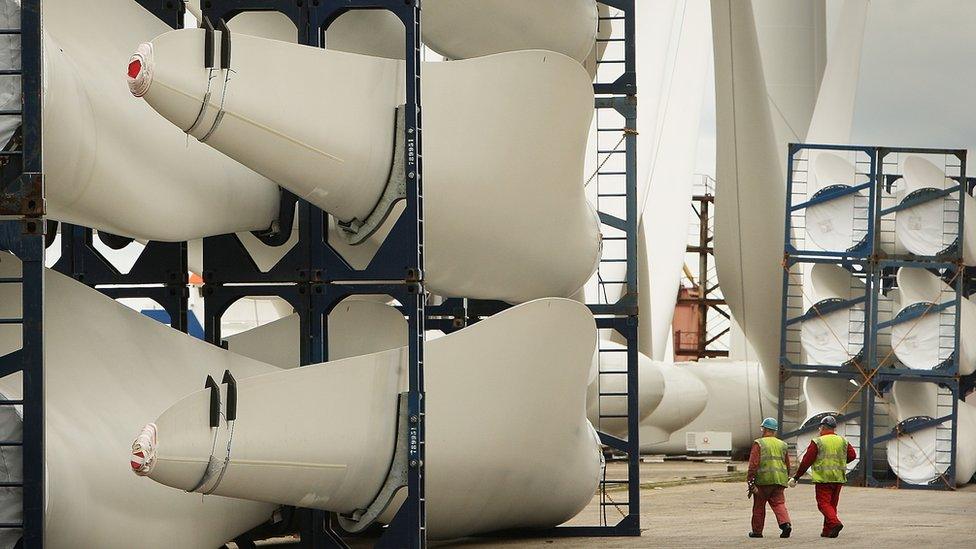
- Published12 March 2024
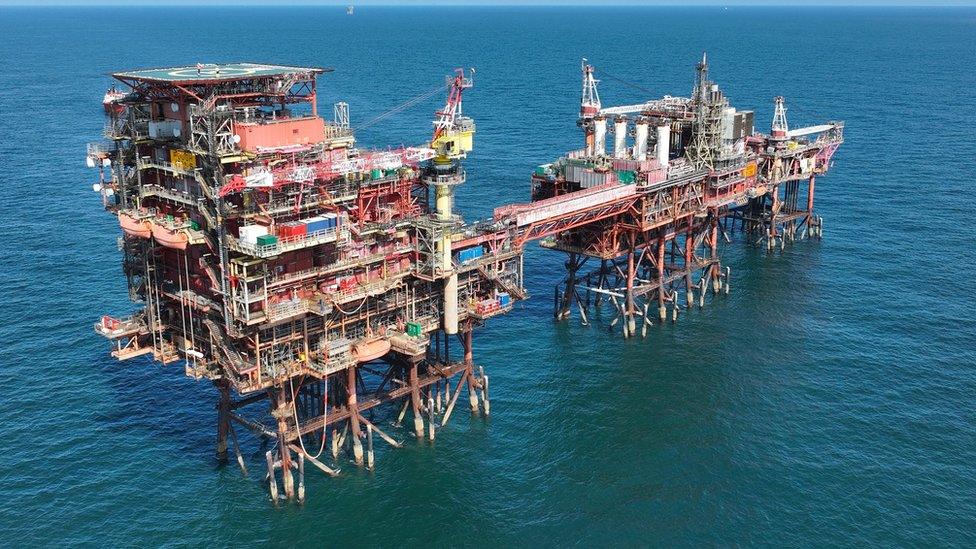
- Published3 March 2023
